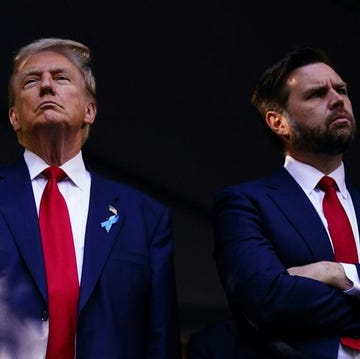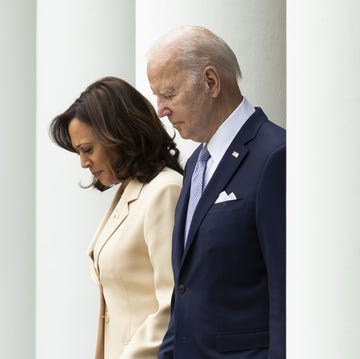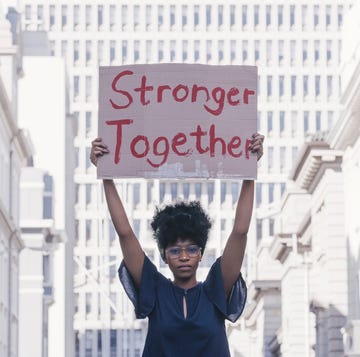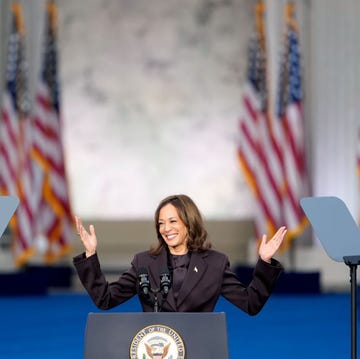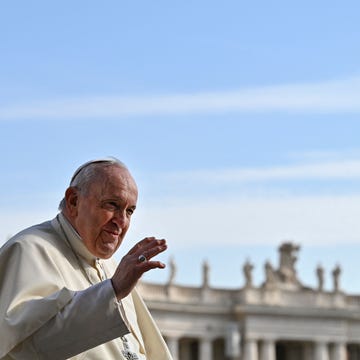More than 40 million Americans have federal student loan debt, amounting to an eye-watering national balance of $1.6 trillion. As voters head to the polling booth this November, their choice in a presidential candidate will ultimately shape what the future of student loan forgiveness looks like. While both nominees (unsurprisingly) have vastly different approaches to the issue, neither has offered specific proposals for how they would take on student loan debt if elected to the White House.
Democratic nominee and Vice President Kamala Harris has been known to champion President Joe Biden’s student-debt-relief program, and she touted a narrower student-loan-forgiveness plan for Pell Grant recipients during her 2019 presidential campaign. As for former President Donald Trump, the Republican nominee has expressed his contempt for Biden’s student-loan-forgiveness plan, and his administration previously deployed several obstacles to debt relief for student borrowers.
Ahead, Bazaar breaks down everything voters should know about the candidates’ positions on student loans.
Kamala Harris
Harris has been a strong proponent of Biden’s plan to tackle student-loan debt relief, with the administration approving the infusion of $175 billion into the Public Service Loan Forgiveness program for more than 4.8 million Americans with student debt, according to an October 2024 press release. (The PSLF program forgives the outstanding student loan debt for public servants, such as teachers or nurses, who make 120 qualifying monthly payments.) Other aspects of Biden’s debt relief plan have faced obstacles from Republicans in court. The president’s initial plan, which could have eliminated $20,000 of student debt for millions of Americans, was blocked by the Supreme Court last year.
Harris’s website states that “she’ll continue working to end the unreasonable burden of student-loan debt and fight to make higher education more affordable so that college can be a ticket to the middle class,” but her campaign team has yet to specify how she would tackle the problem once elected.
During her 2019 presidential run, Harris offered a plan for student-debt relief that was ultimately more limited than Biden’s, proposing a three-year debt-forgiveness program for Pell Grant recipients who open a business in disadvantaged communities. At the time, her plan was criticized for being too narrow in scope.
As a senator for California, Harris backed several legislation proposals to reduce debt for college students: Senator Bernie Sanders and Representative Pramila Jayapal’s College for All Act, which would have made admission to four-year public colleges free for families who made up to $125,000 and community colleges free for everyone; the Debt-Free College Act, which would have established a dollar-for-dollar federal match to universities who committed themselves to helping students pay for admission without taking on debt; and the Basic Act, which would have awarded grants to colleges who met the basic needs of their students, like food and health care. None of the three acts became law.
In summary, Kamala Harris:
- Has been a strong proponent of the Biden administration’s plan to offer relief for student-loan borrowers, although the plan has faced barriers from Republicans and the Supreme Court.
- Remains murky with the specific details on how she’d tackle student loan debt once in office.
- Campaigned for the presidency in 2019 with a student-loan-debt-relief plan that was criticized for being too narrow in scope.
- Previously backed various pieces of legislation that addressed the high cost of university for students, though these acts were never passed into law.
Donald Trump
Trump has previously lauded the Supreme Court’s decision to halt Biden’s student-loan-forgiveness plan, which he called an “unconstitutional student-loan gimmick” in a press release. The decision was signed onto by all three of Trump’s nominees for Supreme Court justice.
Under the Trump administration, Congress enacted a student-loan-payment pause at the height of the Covid-19 pandemic. Trump later extended the pause and waived interest. Still, the former president has a history of presenting obstacles for student-loan borrowers seeking relief.
Despite congressional attempts to make the process for applying to the PSLF program easier, the Education Department denied debt relief to 99 percent of applicants, according to reports released in 2019. Since the PSLF grants debt cancellation for public servants who the required 10 years of monthly payments, the first time anyone would have qualified for the program’s benefits was in 2017, 10 years after the program was signed into law by President George W. Bush in 2007. However, of the 54,184 applications that were received during the first year of the newly expanded program, only 661 applications were approved.
Trump’s nominee to head the Education Department, Betsy DeVos, made multiple controversial decisions during her time in office, including an attempt to defang the Borrower Defense to Repayment rule, which cancels loans for students who were defrauded by their schools. (The department later reversed this decision following DeVos’s resignation in 2021.)
DeVos had several run-ins in court, too. On several occasions, she collected from student loan borrowers after courts ordered her to halt debt collection, leading to the department being held in contempt of court and ordered to pay a $100,000 fine.
In summary, Donald Trump:
- Nominated Supreme Court justices who played a major part in halting Biden’s student-loan-forgiveness plan.
- Paused student-loan payments and waived interest during the height of the Covid-19 pandemic.
- Denied 99 percent of applicants to the PSLF.
- Selected Betsy DeVos to head the Education Department, where she made several controversial decisions regarding student-loan forgiveness and illegally collected debt from student loan borrowers.



